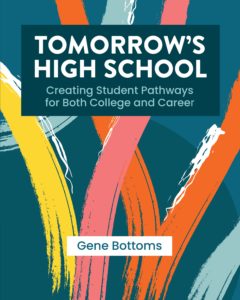Adding Equity to College and Career Pathways
Tomorrow’s High School: Creating Student Pathways for Both College and Career
By Gene Bottoms
(ASCD/SREB, 2022 – Learn more)
Reviewed by Frank J. Hagen
Why is it that our high schools currently perpetuate the traditional practice of selecting and sorting the majority of students for low wage careers with little chance for economic success or upward mobility in the 21st century?
At the other end of the socio-economic continuum, a simple minority of students continue to be prepared for high wage careers coupled with increased economic and social success. This conundrum perpetuates the plight of underserved students.

With the skill of a highly trained thoracic surgeon, he examines and cuts away at the numerous failures of current high school practices. He provides a series of proposed changes to transform current high schools to schools where ALL students are “challenged to move out of the shallow end of the curriculum into deeper learning experiences” by weaving together equally rigorous career and college options.
This is critical to prepare ALL students for economic success and upward mobility in the 21st century. This requires heroic leadership to not only uncover, but address the multiple blind spots in today’s accepted high school practices. The educational and economic impact of the pandemic era make such transformation all the more urgent.
Nine Beliefs to Transform High Schools
Bottoms provides a series of nine beliefs that can overcome the current status-quo complacency so that high schools are transformed to dramatically increase economic opportunity for ALL students. These includes “high expectations” (1) for ALL students, and genuine “family engagement” (2) while “helping students develop a clear vision for the future” (3).
Bottoms calls for “different paths to success” (4) coupled with a “growth mindset” (5), “teacher expertise” (6) and “professional growth” (7). It is necessary for both “Boards and System Leaders” (8) to act as allies rather than roadblocks or obstacles and fully support “Principal Leadership” (9).
Each of the nine beliefs alone is not sufficient to tackle the current state of high schools. However, together they form a synergistic model for change contributing to student success in the classroom and, ultimately, economic success and upward mobility in the 21st century.
Bottoms, who also founded the Making Middle Grades Work network, doesn’t ignore the important role of the upper middle grades in supporting these improvements by broadening and deepening math and literacy learning. This excerpt states his outlook succinctly.
Recognizing the Role of Middle School
in Improving High School Outcomes
The connection between middle school and high school is a critical piece of any district’s ability to meet bold graduation goals. An attitude prevails in some systems that the mission of middle school falls outside the realm of rigorous academic preparation – that academic learning is a responsibility best left to the high schools, while educators in the middle focus on the transition through adolescence.
The most successful middle schools understand that their emerging adults need to be fully equipped for a successful life and that students cannot take a detour around serious studies for three or four critical years.
No one argues that adolescence is a challenging time, and middle school educators have an important role in supporting young people through this stage of development. But, as highly successful middle-level teachers have demonstrated, that role can be fulfilled while also supporting and preparing students in grades 6 through 8 for rigorous high school studies that lead to most students graduating ready for some level of postsecondary education.
Breaking down traditional barriers and stereotypes that make middle/high school collaboration so difficult is essential. It will require an intensive effort—with all “eyes on the prize”—to align the middle school curriculum to high school readiness standards for literacy, mathematics, and science, and to create rigorous pathways toward success.
– Excerpt, Tomorrow’s High School, ASCD, 2022)
What Do We Truly Want for All Students?
In Tomorrow’s High School, Gene Bottoms presents a lucid summary of what needs to happen and why it must happen sooner rather than later. He asks educators to stop, step back from today, and take this pledge: “We will fully prepare and graduate every student so that he or she is ready for postsecondary studies and career opportunities leading to an economically, socially, and critically rewarding life.”
I highly recommend this book and its Bold Goals for study and discussion among school board members, district leadership, high school and middle school principals, and teacher leaders.
Frank J. Hagen is a retired school principal who currently teaches school leadership courses at Wilmington University where he has taught for the past 20 years. He was a highly successful school principal in both Delaware and Maryland for over 24 years and was selected as Delaware’s School Principal of the Year in 1993.
Throughout his career, Frank has served on a number of leadership committees and presented at national, regional, and local school leadership conferences including the National Association for Secondary School Principals and the Southern Regional Education Board. He has served in a number of interim school leadership positions in select public and charter schools since retiring in 2007 as well as consulting with McREL International and the Delaware Academy for School Leadership (University of Delaware).































